Costumbrismo
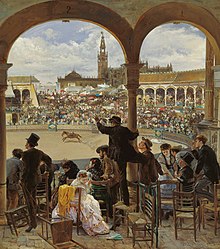
Costumbrismo(in Catalan:costumisme;sometimes anglicized ascostumbrism,with the adjectival formcostumbrist) isthe literaryor pictorial interpretation of local everyday life, mannerisms, and customs, primarily in theHispanicscene, and particularly in the 19th century.Costumbrismois related both to artisticrealismand toRomanticism,sharing the Romantic interest in expression as against simple representation and the romanticandrealist focus on precise representation of particular times and places, rather than of humanity in the abstract.[1][2]It is often satiric and even moralizing, but unlike mainstream realism does not usually offer or even imply any particular analysis of the society it depicts. When not satiric, its approach to quaintfolkloricdetail often has a romanticizing aspect.
Costumbrismocan be found in any of the visual or literary arts; by extension, the term can also be applied to certain approaches to collecting folkloric objects, as well. Originally found in short essays and later in novels,costumbrismois often found in thezarzuelasof the 19th century, especially in thegénero chico.Costumbristamuseums deal with folklore and local art andcostumbristafestivals celebrate local customs andartisansand their work.
Although initially associated with Spain in the late 18th and 19th century,costumbrismoexpanded tothe Americasand set roots in the Spanish-speaking portions of the Americas, incorporating indigenous elements. Juan López Morillas summed up the appeal ofcostumbrismofor writing about Latin American society as follows: thecostumbristas'"preoccupation with minute detail, local color, the picturesque, and their concern with matters of style is frequently no more than a subterfuge. Astonished by the contradictions observed around them, incapable of clearly understanding the tumult of the modern world, these writers sought refuge in the particular, the trivial or the ephemeral."[3]
Literarycostumbrismoin Spain
[edit]Origins
[edit]
Antecedents tocostumbrismocan be found as early as the 17th century (for example in the work of playwrightJuan de Zabaleta) and the current becomes clearer in the 18th century (Diego de Torres Villarroel,José Clavijo y Fajardo,José Cadalso,Ramón de la Cruz,Juan Ignacio González del Castillo). All of these writers have, in at least some of their work, an attention to specific, local detail, an exaltation of the "typical" that would feed into bothcostumbrismoand Romanticism. In the 19th centurycostumbrismobursts out as a clear genre in its own right, addressing a broad audience: stories and illustrations often made their first or most important appearance in cheap periodicals for the general public.[4]It is not easy to draw lines around the genre:Evaristo Correa Calderónspoke of its "extraordinary elasticity and variety".[5]Some of it is almost reportorial and documentary, some simply folkloric; what it has in common is the effort to capture a particular place (whether rural or urban) at a particular time.[4]

Sebastián de Miñano y Bedoya(1779–1845) is considered by some acostumbrista,although arguably his writing is too political to properly fit the genre. According to Andrés Soria, the first incontestablecostumbristasare the anonymous and pseudonymous contributors toLa Minerva(1817),El Correo Literario y Mercantil(1823–33) andEl Censor(1820–23). Later come the major figures ofliterarycostumbrismo:Serafín Estébanez Calderón(1799–1867),Ramón de Mesonero Romanos(1803–82), andMariano José de Larra(1809–37) who sometimes wrote under the pseudonym "Fígaro". Estébanez Calderón (who originally wrote for the abovementionedCorreo Literario y Mercantil) looked for a "genuine" and picturesque Spain in the recent past of particular regions; Mesonero Romanos was a careful observer of theMadridof his time, especially of the middle classes; Larra, according toJosé Ramón Lomba Pedraja,arguably transcended his genre, using the form ofcostumbrismofor political and psychological ideas. Anafrancesado—aliberalchild ofthe Enlightenment—he was not particularly enamored of the Spanish society that he nonetheless observed minutely.[4]
Costumbrismowas by no means without foreign influences. The work ofJoseph AddisonandRichard Steelenearly a century earlier inThe Spectatorhad influenced French writers, who in turn influenced thecostumbristas.Furthermore, Addison and Steele's own work was translated into Spanish in the early 19th century, and Mesonero Romanos, at least, had read it in French.[4]Still, an even stronger influence came by way ofVictor-Joseph Étienne de Jouy(whose work appeared in translation inLa MinervaandEl Censor),Louis-Sébastien Mercier(especially forLe Tableau de Paris,1781–88),Charles Joseph Colnet Du Ravel,andGeorges Touchard-Lafosse.[4]In addition, there were the travelogues such asRichard Ford'sA Handbook for Travellers in Spain,written by various foreigners who had visited Spain and, in painting, the foreign artists (especially,David Roberts) who had settled for a time especially inSevilleandGranadaand drew or painted local subjects.[2]
While Estébanez Calderón, Mesonero Romanos, and (insofar as he fits the genre) Larra were the majorcostumbristawriters, many other Spanish writers of the 19th century devoted all or part of their careers tocostumbrismo.Antonio María Segovia(1808–74), who mainly wrote pseudonymously as "El Estudiante"[4]and who founded the satiric-literary magazineEl Cócora;[6]his collaboratorSantos López Pelegrín(1801–46), "Abenámar"; many early contributors to Madrid'sSemanario Pintoresco Español(1836-57[7]), Spain's first illustrated magazine; and such lesser lights asAntonio Neira de Mosquera(1818–53), "El Doctor Malatesta" (Las ferias de Madrid,1845);Clemente Díaz,with whomcostumbrismotook a turn toward the rural;Vicente de la Fuente(1817–89), portraying the lives of bookish students (in between writing serious histories);José Giménez Serrano,portraying a romanticAndalusia;Enrique Gil y Carrasco,[4]aCarlist[8]fromVillafranca del Bierzo,friend ofAlexander von Humboldt,and contributor to theSemanario Pintoresco Español;[9]and many other regionalists around Spain.[4]
The Spanish Drawn By Themselves
[edit]
Much as literarycostumbrismohad been influenced by English models, often by way of France, the same occurred with the equivalent in the visual arts, but with far more recent models. In a period whenphysiognomywas in vogue,Heads of the People or Portraits of the Englishwas serialized in London starting in 1838 and was published in its entirety in 1840–41. It combined essays by such "distinguished writers" (the volume's own choice of words) asWilliam Makepeace ThackerayandLeigh Huntwith pictures of individuals emblematic of different English "types". This was followed in France by a work first serialized asLes Français, Moeurs Contemporaines( "The French, Contemporary Manners", beginning in 1839) and published in a volume in 1842 asLes Français peints par eux-mêmes. Encyclopédie Morale du dixneuviéme siécle( "The French, drawn by themselves. Moral Encyclopedia of the 19th Century" ). The Spanish soon followed withLos españoles pintados por sí mismos( "The Spanish Drawn By Themselves" ) serialized from 1842 and published in a volume in 1843.[4][10]

A collective and hence, necessarily, uneven anthology of "types",Los españoles…was a mixture of verse and prose, and of writers and artists from various generations. Illustrators includedLeonardo Alenza(1807–45),Fernando Miranda y Casellas,Francisco Lameyer(1825–1877),Vicente Urrabieta y Ortiz,andCalixto Ortega.The writers included Mesonero and Estébanez as well as various lesscostumbristawriters and many not usually associated with the genre, such asGabriel García Tassara(1817–75) or the conservative politicianFrancisco Navarro Villoslada(1818–95). Andrés Soria remarks that, except for the Andalusian "types", everything was from the point of view of Madrid. Unlike latercostumbrismo,the focus remained firmly on the present day. In some ways, the omissions are as interesting as the inclusions: no direct representation of the aristocracy, of prominent businessmen, of the high clergy, or of the army, and except for the "popular" classes, the writing is a bit circumspect and cautious. Still, the material is strong on ethnological, folkloric, and linguistic detail.[4]
In an epilogue toLos españoles…,"Contrastes. Tipos perdidos, 1825, Tipos hallados, 1845" ( "Contrasts. Types lost, 1825, types found, 1845" ), Mesonero on the one hand showed that the genre, in its original terms, was played out, and on the other laid the ground for futurecostumbrismo:new "types" would always arise, and many places remained to be written about in this fashion. The book had many descendants, and a major reissue in 1871. A particularly strong current came out ofBarcelona:for example,José M. de Freixas'sEnciclopedia de tipos vulgares y costumbres de Barcelona( "Encyclopedia of vulgar types and customs of Barcelona", 1844) illustrated by Servat,[4][11]andEl libro Verde de Barcelona( "The Green Book of Barcelona", 1848) by "José y Juan" (José de MajarrésandJuan Cortada y Sala.The very title ofLos valencianos pintados por sí mismos(Valencia1859) gave a nod of the hat to the earlier work,[4]
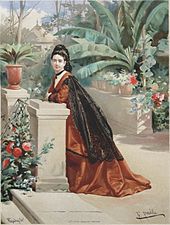
A revival of collective works ofcostumbrismoin the time of theFirst Spanish Republicsaw the reissue ofLos españoles…(1872), as well as the publication ofLos españoles de hogaño( "The Spanish these days", 1872), focused on Madrid, and the vast undertakingLas mujeres españolas, portuguesas y americanas…( "Spanish, Portuguese, and American Women…", published in Madrid,Havana,andBuenos Airesin 1872–1873 and 1876).[4][12]Also from this time was the satiricMadrid por dentro y por fuera( "Madrid from inside and outside, 1873) by Manuel del Palacio (1831–1906).[4][13]
Carlos Frontauracarried oncostumbrismoin Madrid withLas tiendas( "Shops", 1886) and "Tipos madrileños" ( "Madrid types", 1888).Ramón de Navarrete(1822–1897) writing variously as or "Asmodeo" (afterAsmodeus,king of the demons), broke with the history of the genre by writing of the upper classes in Madrid during theRestoration,as in hisSueños y realidades ( "Dreams and realities,1878).Enrique Sepúlvedawrote about[4]both Madrid[13]and Barcelona, Narcís Oller (1846–1930) about Barcelona,[4]andSabino de Goicoechea(1826–1901), known as "Argos", about the Basque Country.[4][14]Galiciawas represented by the collective workEl álbum de Galicia. Tipos, costumbres y leyendas( "The album of Galicia. Types, customs and legends", 1897).[4]
Yesterday, Today, and Tomorrow
[edit]
Poet, journalist and pamphleteerAntonio Flores Algovia(1821–65), one of the contributors toLos españoles...followed up in 1846 withDoce españoles de brocha gorda, que no pudiéndose pintar a sí mismos, me han encargado a mí, Antonio Flores, sus retratos[4][15]( "Twelve Spaniards with a broad brush, who not being able to portray themselves have put me, Antonio Flores, in charge of their portraits" ), subtitled a "novel of popular customs" ("novela de costumbres populares"). Published in 1846 and reissued several times, the book merged the hitherto more essayisticcostumbristaform with aspects of thenovel(although not a particularly tightly plotted novel). Somewhat more novelistic was hisFe, Esperanza y Caridad( "Faith Hope and Charity" ), published serially inLa Naciónin 1850–1851 and also much reprinted. Flores had beenEugène Sue's translator into Spanish, and Sue's influence is strong in this work. Flores turned to again tocustumbrismo,of a sort, in 1853 withAyer, hoy y mañana o la fe, el vapor y la electricidad (cuadros sociales de 1800, 1850 y 1899)( "Yesterday, today and tomorrow or faith, steam and electricity (social pictures of 1800, 1850, and 1899)" ) going Mesonero's "types lost" and "types found" one better by projecting a vision of the future influenced by the work ofÉmile Souvestre.His newspaperEl Laberintocontinued publishing hiscostumbristawork even posthumously, such asTipos y costumbres españolas(1877).[4]
Eugenio de Ochoa(1815–72) carriedcostumbrismoin a different direction.[4]Born in theBasque country[16]and moving often between Spain and France, his 1860 bookMuseo de las familias. París, Londres y Madrid( "Museum of families. Paris, London, Madrid" ) created a sort of cosmopolitancostumbrismo.[4]
Costumbrismoby major Spanish realists
[edit]Many of the great Spanish realist writers of the 19th century worked at times in thecostumbristamode, especially at the start of their careers.Fernán Caballero(pen name of Cecilia Francisca Josefa Böhl de Faber) (1796–1877), for example, in the prose portions of herCuentos y poesías populares andaluzas( "Popular Andalusian stories and poems", collected in 1859 from prior publication in magazines), writes within the genre, particularly in "Una paz hecha sin preliminares, sin conferencias y sin notas diplomáticas" ( "A peace made without preliminaries, without conferences, and without diplomatic notes" ), with its very specific setting inChiclana de la Frontera.[4][17]Pedro Antonio de Alarcón(1833–1891) issued a collectionCosas que fueron,bringing together 16costumbristaarticles.[4]

Andrés Soria seesJosé María de Pereda(1833–1906) as the most successful fusion ofcostumbristascenes into proper novels, especially his portrayals ofLa Montaña,the mountainous regions ofCantabria.HisEscenas montañesas(1864) is particularly in thecostumbristamode, with its mixture of urban, rural and seafaring scenes, and sections offering sketches of various milieus.[4]Poet and novelistAntonio de Trueba(1819 or 1821–89) wrote squarely within the genre withMadrid por fueraandDe flor en flor.Gustavo Adolfo Bécquer(1836–1870) portrayed Madrid, Seville, andToledo.José María Gabriel y Galán(1870–1905), best known as a poet, also wrotecostumbristapieces aboutSalamanca.Armando Palacio Valdés(1853–1938) also essayed the genre in newspaper articles, collected inAguas fuertes( "Strong waters", 1884). The writer and diplomatÁngel Ganivet(1865–98),[4]seen by some as a precursor to theGeneration of '98,[18]wrotecostumbristascenes ofGranada.[4]
Elements ofcostumbrismo,or even entire works in the genre, can be found among major Spanish writers of the 20th century, though to a lesser extent.Miguel de Unamuno(1864–1936) worked in the genre forDe mi país( "Of my country", 1903) and some stories such as "Solitaña" in ofEl espejo de la muerte( "The Mirror of Death", 1913), as didPío BarojawithVitrina pintoresca( "Picturesque showcase", 1935) and in passages of his novels set in the Basque Country.Azorín(José Augusto Trinidad Martínez Ruíz, 1873–1967) often wrote in this genre; one could comb the works ofRamón Gómez de la Serna(1888–1963) andCamilo José Cela(1916–2002) and find many passages that could come straight from a work ofcostumbrismo.Although taken as a whole these writers are clearly notcostumbristas,they use thecostumbristastyle to evoke surviving remnants of Spain's past.[4]
20th century literarycostumbrismoin Spain
[edit]The tradition ofcostumbrismoin Spain by no means ended at the turn of the century, but it simply did not play as important a role in 20th-century Spanish literature as it did in the century before. As notedabove,several of the most important 20th-century Spanish writers at least dabbled in, or were influenced by, the genre. When we go beyond the first string of writers, we see more of a continuation ofcostumbrismo.[4]
In the course of the century, more and more Spanish regions asserted their particularity, allowing this now established technique of writing to be given new scope. In other regions—Madrid, Andalusia—costumbrismoitself had become part of the region's identity. The magazineEspaña,founded 1915, wrote about some new "types": the indolentgolfo;the lower classseñorito chulowith his airs and exaggerated fashions; thealbañilor construction worker, but with far less sympathy thancostumbristasin the previous century had portrayed their predecessors. Other "types" were those who were a caricature of times past:el erudito,with his vast but pointless book-learning, orEl poeta de juegos florales( "the poet of floral games" ).[4]

Andrés Soria describes 20th century regionalcostumbrismoas more serious, less picturesque, and more poetic than in the 19th century. Among his many examples of the 20th century continuation ofcostumbrismoareSantiago Rusiñol(1861–1931), writing inCatalanaboutCataloniaandMallorca;numerous chroniclers of the Basque Country:José María Salaverría(1873–1940),Ricardo Baroja(1871–1953),Dionisio de Azkue( "Dunixi" ),José María Iribarren(1906–1971), and, as mentioned above, Pío Baroja;Vicente Blasco Ibáñez(1867–1928) writing about Valencia; andVicente Medina Tomás(1866–1937), writing about Murcia.[4]
A strong current ofcostumbrismocontinued in 20th-century Madrid, including in poetry (Antonio Casero,1874–1936) and theatre (José López Silva,1860–1925;Carlos Arniches Barreda,1866–1943). Other writers who continued the tradition wereEusebio Blasco(1844–1903),Pedro de Répide(1882–1947),Emiliano Ramírez Ángel(1883–1928),Luis Bello(1872–1935), andFederico Carlos Sainz de Robles(1899–1983). Similarly, 20th century Andalusia saw work byJosé Nogales(1860?–1908),Salvador Rueda(1857–1933),Arturo Reyes(1864–1913), José Mas y Laglera (1885–1940),Ángel Cruz Rueda(1888–1961), andAntonio Alcalá Venceslada(1883–1955).[4]
Costumbrismoin the visual arts in Spain
[edit]
Costumbrismo is an art form developed by Spanish painters. In the 19th century, a wave of nationalistic fervour took hold, providing the stimulus for painters to focus on local customs (orcostumbres).[19]As in literarycostumbrismo,Madrid and Andalusia (particularly Seville) were Spain's two great centers ofcostumbrismoin the visual arts. Andalusiancostumbristapaintings were mainly romantic and folkloric, largely devoid of social criticism. Much of their market was to foreigners for whom Andalusia epitomized their vision of a Spain distinct from the rest of Europe. Thecostumbristaartists of Madrid were more acerbic, sometimes even vulgar, in portraying the life of lower class Madrid. More of their market was domestic, including to the often snobbish (and often Europeanizing and liberal) elite of the capital.[2][20]Among other things, the School of Madrid often used large masses of solid color and painted with a broad brush, while the School of Seville painted more delicately. The Madrid paintings have a certain urgency, while the Seville paintings are typically serene, even misty. The Madrid painters focus more on unique individuals, the Sevillianos on individuals as representatives of a type.[2]

Romantic Andalusiancostumbrismo(costumbrismo andaluz) follows in the footsteps of two painters of the School of Cádiz,Juan Rodríguez y Jiménez,"el Panadero" ( "the Baker", 1765–1830) andJoaquín Manuel Fernández Cruzado(1781–1856), both associated with Romanticism. The trend was continued by the School of Seville, in a city much more on the path of a foreign clientele. The founding figure wasJosé Domínguez Bécquer(1805–41), father of the poet Gustavo Adolfo Bécquer (seeabove) and painterValeriano Bécquer(1833–70), who moved to Madrid. Domínguez Bécquer's influence came as an art teacher, as well as an artist. His student and cousinJoaquín Domínguez Bécquer(1817–79) was known for his acute observation of light and atmosphere. Another of José Domínguez Bécquer's students, the bold and forcefulManuel Rodríguez de Guzmán(1818–67), may have been the genre's strongest painter.[20]
Other important early figures wereAntonio Cabral Bejarano(1788–1861), best known for paintings of individuals theatrically posed against rural backgrounds, and an atmosphere reminiscent ofMurillo,andJosé Roldán(1808–71), also very influenced by Murillo, known especially as a painter of children and urchins. One of Cabral Bejarano's sons,Manuel Cabral Bejarano(1827–91) began as acostumbrista,but eventually became more of arealist.Another son,Francisco Cabral Bejarano(1824–90), also painted in the genre.[20]
Other painters of the School of Seville wereAndrés Cortés(1810–79),Rafael García Hispaleto(1833–54), Francisco Ramos, and Joaquín Díez; history painterJosé María Rodríguez de Losada(1826–96); and portraitistJosé María Romero(1815–80).[20]
Typical subject matter includedmajos(lower classdandies) and their female equivalents, horsemen, bandits and smugglers, street urchins and beggars, Gypsies, traditional architecture, fiestas, and religious processions such asHoly Week in Seville. [2]
The School of Madrid was united less by a common visual style than by an attitude, and by the influence ofGoyarather than Murillo.[2][20]Notable in this school wereAlenzaandLameyer,both contributors toLos españoles pintados por sí mismos.Alenza, in particular, showed a strong influence from theFlemishpainters as well as from Goya. A fine portraitist who tended to take his subjects from among the common people, in some ways he epitomizes the difference between the School of Madrid and that of Seville. For him the "official" Romanticism was a topic to satirize, as in his series of paintingsSuicidios románticos( "Romantic suicides" ).[20]
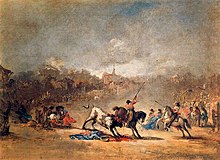
Probably foremost in the School of Madrid wasEugenio Lucas Velázquez(1817–70). An artistic successor to Goya (though a more erratic painter than the master), Lucas Velázquez's work ranged frombullfightingscenes toOrientalismto scenes ofwitchcraft.His sonEugenio Lucas Villamil(1858–1918) and his studentsPaulino de la Linde(1837-?) andJosé Martínez Victoriafollowed in his tracks; he was also a strong influence onAntonio Pérez Rubio(1822–88) andÁngel Lizcano Monedero(1846–1929).[20]
José Elbo(1804–44) was at least strongly akin to the School of Madrid. Although born inÚbedain the AndalusianprovinceofJaén,Elbo studied painting in Madrid underJosé Aparicio(1773–1838), and was influenced by Goya; he was also influenced by theCentral Europeanequivalents ofcostumbrismo.His painting is rife with social criticism, and often angrily populist.[20]
Also in Madrid, but not really part of the School of Madrid, was Valeriano Bécquer (transplanted son of José Domínguez Bécquer). Although also influenced by Goya (and byDiego Velázquez), his work in Madrid did partake of some of the socially critical aspects of the other painters of that city, but not of the satiric aspects: his portraits of common people emphasize their dignity, seldom their foibles.[20]
The dark vision of 20th-century Madrid painterJosé Gutiérrez Solana(1886–1945) was influenced bycostumbrismoand also directly by theBlack Paintingsof Goya that had so influenced thecostumbristas.[4]
Visualcostumbrismoin the Americas
[edit]
In nineteenth-century Mexico, colonial-eracasta paintings,a type of seculargenre paintingdepicting racial categories and hierarchy disappeared at independence when casta categories were abolished, but costumbrismo paintings resonated with the stereotypes of the earlier genre.[21]A number of foreign visitors to Mexico produced images in the costumbrista tradition, includingClaudio Linati[22]andEdouard Pingret.The most significant Mexican costumbrista painter isJosé Agustín Arrieta,whose paintings of a market scene ("La Sorpresa"), a kitchen scene ("La Cocina Poblana"), and a tavern scene (Tertulia de pulquería) are well known.[23][24][25]One less famous than Arrieta isManuel Serrano(ca. 1830-ca. 1870s), about whom little is known. His paintingVendador de buñuelos,depicting a fritter seller in an urban night scene is in the collections of the Mexican government.[26]Another less well known Mexican artist ises:Felipe Santiago Gutiérrez(1824-1904), who was also a writer, teacher, art critic, intellectual, and cultural diplomat. "[27]
-
Still Life with Cat and Birds. Agustín Arrieta.
Literarycostumbrismoin the Americas
[edit]Argentina
[edit]
Some ofArgentina's most distinguished writers worked in thecostumbristagenre in at least some of their writing, though few worked narrowly within the genre.Esteban Echeverría(1805–51) was a politically passionate Romantic writer whose work has strongcostumbristaaspects; hisEl Matadero( "The Slaughterhouse" ) is still widely read.Juan Bautista Alberdi(1810–84) andDomingo Faustino Sarmiento(1811–1888) both wrote at times in the genre, as didJosé Antonio Wilde(1813–83), inBuenos Aires desde setenta años atrás( "Buenos Aires from seventy years ago" );Vicente G. Quesada(1830–1913), inRecuerdos de un viejo( "Memories of an old man" );Lucio V. López(1848–94), in the novelaLa gran aldea( "The big village" );Martín Coronado(1850–1919), playwright;Martiniano Leguizamón(1858–1935), in the novelMontaraz;José S. Alvarez(1858–1903, "Fray Mocho" ), in the story "Viaje al país de los matreros" ( "A trip to bandit country" );Emma de la Barra(1861–1947), who wrote under the pseudonymCésar Duayen,inStella;Joaquín V. González(1863–1923), inMis montañas( "My Mountains" );Julio Sánchez Gardel(1879–1937), in numerous comedies; andManuel Gálvez(1882–1962), in such novels asLa maestra normal( "Thenormal schoolteacher ") andLa sombra del convento( "The sleep of the convent" ).[28]
Bolivia
[edit]BoliviancostumbristasincludeJulio Lucas Jaimes(1845–1914),Lindaura Anzoátegui de Campero(1846–98),Jaime Mendoza(1874–1938),Alcides Arguedas(1879–1946), andArmando Chirveches(1881–1926).[28]
Central America
[edit]Guatemalannovelist and historianJosé Milla(1822–82) wrote severalcostumbristaworks and created the character ofJuan Chapín,the emblematic Guatemalan. Other Central AmericancostumbristasareJosé María Peralta Lagos(1875–1944,El Salvador),Ramón Rosa(1848–93,Honduras),Carlos Alberto Uclés(1854–1942, Honduras), and a distinguished line ofCosta Ricanwriters:Manuel de Jesús Jiménez(1854–1916),Manuel González Zeledón(1864–1936), the verse writerAquileo Echeverría(1866–1909), and, in the 20th century,Joaquín García Monge(1881–1958).[28]
Chile
[edit]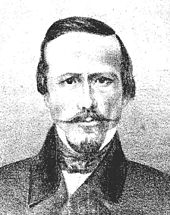
CostumbrismoentersChilean literaturein some of the writing ofJosé Zapiola(1804–85),Vicente Pérez Rosales(1807–86),Román Fritis(1829–74),Pedro Ruiz Aldea(ca. 1833–70) and especiallyJosé Joaquín Vallejo(1811–58), who under the name "Jotabeche" was the supreme Chileancostumbrista.[28]
Strong aspects ofcostumbrismocan be seen in the novels and other works ofAlberto Blest Gana(1830–1920). There are manycostumbristapassages in the works ofBenjamín Vicuña Mackenna(1831–86) andDaniel Barros Grez(1833–1904);Román Vial(1833–1896) entitled one of his booksCostumbres chilenas;Zorobabel Rodríguez(1839–1901),Moisés Vargas(1843–98),Arturo Givovich(1855–1905), Daniel Riquelme (1854–1912),Senén Palacios(1858–1927),Egidio Poblete(1868–1940) all wrote in the mode at times.Costumbrismofigures particularly heavily in stage comedies:El patio de los Tribunales( "The courtyard of the tribunals [of justice]", byValentín Murillo(1841–1896);Don Lucas Gómez,byMateo Martínez Quevedo(1848–1923);Chincol en sartén( "A sparrow in the pan" ) andEn la puerta del horno( "In thegate of horn"), byAntonio Espiñeira(1855–1907);La canción rota( "The broken song" ), byAntonio Acevedo Hernández(1886–1962);Pueblecito( "Little town" ) byArmando Moock(1894–1942). In prose,costumbrismomixes eventually into realism, withManuel J. Ortiz(1870–1945) andJoaquín Díaz García(1877–1921) as important realists withcostumbristaaspects.[28]
Colombia
[edit]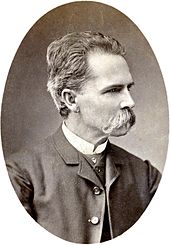
Colombiacan claim one of the earliest antecedents to thecostumbrismoinEl Carnero(written 1636–38, but not published until 1859) byJuan Rodríguez Freile(1566–1638 or 1640).[29]Rodríguez's work begins as a chronicle of the conquest ofNew Granada,but as it approaches his own time it becomes more and more detailed and quotidian, and its second half is a series of narratives that, according to Stephen M. Hart, give "lip service" to conventional morality while taking "a keen delight in recounting the various skullduggeries of witches, rogues, murderers, whores, outlaws, priests and judges."[30]
Colombia can also claim a particularly rich tradition ofcostumbrismoin the 19th century and into the 20th:José Manuel Groot(1800–78); novelistsEugenio Díaz(1803–65),José Manuel Marroquín(1827–1908), andJosé María Vergara y Vergara(1831–72), all of whom collaborated on the magazineEl Mosaico, la revista bogotana del costumbrismo(1858–71);Luis Segundo Silvestre(1838–87); andJorge Isaacs(1837–95), whose sole novelMaríawas praised by Alfonso M. Escudero as the greatest Spanish-language romantic novel.[28]
Other ColombiancostumbristasareJosé Caycedo Rojas(1816–1897),Juan de Dios Restrepo(1823–94),Gregorio Gutiérrez González(1826–72),Ricardo Carrasquilla(1827–86),Camilo A. Echeverri(1827–87),Manuel Pombo(1827–98),José David Guarín(1830–90),Ricardo Silva(1836–87),José María Cordovez Moure(1835–1918),Rafael María Camargo(1858–1926; wrote under the pseudonymFermín de Pimentel y Vargas), andTomás Carrasquilla(1858–1940).[28]
Cuba
[edit]Cuba's leadingcostumbristaswereGaspar Betancourt Cisneros(1803–66, known as "El Lugareño" ),Cirilo Villaverde(1812–94), andJosé María de Cárdenas y Rodríguez(1812–82). The patrician Betancourt published a series ofEscenas cotidianas que abren camino al costumbrismo en Cuba( "Everyday scenes that pave the way forcostumbrismoin Cuba, 1838–40). His work focused often on what he found vulgar or ridiculous about Cuban life, but was written with a fatherly affection. Villaverde, probably Cuba's greatestcostumbrista,wrote romantic novels, most notablyCecilia Valdés(the first part of which was published in 1839, although the definitive version was not published until 1882). Thiscostumbristaanti-slaverynovel can be seen as an early realist work, and continues to be read in recent times. Villaverde also wrote the prologue for Cárdenas's 1847 collection ofcostumbristaarticles.[28]
José Victoriano Betancourt(1813–75) was patron to many intellectuals in 1860sHavana;he later went into exile in Mexico. He is best remembered today as acostumbristawriter, as is another Betancourt,José Ramón Betancourt(1823–90), author ofUna feria de caridad en 183…(ellipses in original title), set inCamagüeyin the late 1830s.[28][31]
Dominican Republic
[edit]In theDominican Republic,Francisco Gregorio Billini(1844–94) stands out for his novelBaní o Engracia y Antoñita(1892).[28]Still, in some ways, his vision was narrow. J. Alcántara Almánzar remarks that "black people are practically absent as important characters, and this absence is very significant in a country whose majority is 'mulatto'." Blacks are more present in thecostumbristaworks ofCesar Nicolas Penson(1855–1901), but he is far more sympathetic to his white characters, portrayingHaitiansas fierce beasts.[32]
Ecuador
[edit]Ecuadorianswho wrote at least part of the time in thecostumbristamode includePedro Fermín Cevallos(1812–93),Juan León Mera(1832–94),José Modesto Espinosa(1833–1915),Carlos R. Tobar(1854–1920),Honorato Vázquez(1855–1933),Víctor M. Rendón(1859–1940),J. Trajano Mera(1862–1919), andLuis A. Martínez(1868–1909).[28]Another Ecuadorian[28]wasAlfredo Baquerizo Moreno(1859–1951), a novelist[28]and later president of the country.[33]
Mexico
[edit]Mexicancostumbrismocan claim one of the longest lineages to be found in the Americas. In the same era in which the genre was gaining an identity in Spain,José Joaquín Fernández de Lizardi(1776–1827) Mexico's first novelist (and perhaps Latin America's first novelist) wrote works that had many similar aspects, includingPeriquillo Sarniento(1816), recently translated into English asThe Mangy Parrot.[28][34]Other MexicancostumbristasareGuillermo Prieto(1818–97) andJosé Tomás de Cuéllar(1830–94). In addition,José López Portillo y Rojas(1850–1923),Rafael Delgado(1853–1914),Ángel del Campo(1868–1908) andEmilio Rabasa(1856–1930) can be seen ascostumbristas,but their work can also be considered realist.[28]
Paraguay
[edit]ParaguayancostumbristasincludeTeresa Lamas de Rodríguez Alcalá(1887–1976) andCarlos Zubizarreta(1904–72).[28]
Peru
[edit]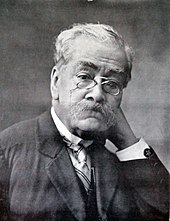
Peruviancostumbrismobegins withJosé Joaquín de Larriva y Ruiz(1780–1832), poeta and journalist and his younger, irreverent, Madrid-educated collaboratorFelipe Pardo y Aliaga(1806–68). A more festive and comic note was struck byManuel Ascensio Segura(1805–71).Manuel Atanasio Fuentes(1820–29) wrote verse under the nameEl Murciélago( "the Bat" ), a name which he also gave to a magazine he founded.[28]
Ricardo Palma(1833–1919), best known for the multi-volumeTradiciones peruanas,was a man of letters, a former liberal politician and later the director of theNational Library of Peru,who rebuilt the collection of that library after theWar of the Pacific.He referred to his works in this mode astradiciones,rather thancostumbrismo.[28][35]
Other Peruviancostumbristasare satirist and verse writerPedro Paz Soldán y Unanue(1839–1895),Abelardo M. Gamarra(1850–1924), and the nostalgicJosé Gálvez(1885–1957).[28]
Puerto Rico
[edit]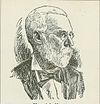
InPuerto Rico,Manuel A. Alonso(1822–89) publishedEl gibaro: cuadro de costumbres de la isla de Puerto Rico(TheJíbaro[modern spelling]: picture of customs of the island of Puerto Rico ", 1849), Puerto Rico's most important contribution to the genre.Manuel Fernández Juncos(1846–1928), born inAsturias,Spain, emigrated at age eleven to the island and wroteTipos y caracteres y Costumbres y tradiciones( "Types and characters and customs and traditions" ).[28][36]
Uruguay
[edit]ProminentUruguayancostumbristasincludeSantiago Maciel(1862–1931),Manuel Bernárdez(1867–1942),Javier de Viana(1868–1926),Adolfo Montiel Ballesteros(1888–1971), andFernán Silva Valdés(1887–1975). Most of these writers also did significant work outside of the genre.[28]
Venezuela
[edit]
VenezuelancostumbristasincludeFermín Toro(c.1807–65),[37]Daniel Mendoza(1823–67),Francisco de Sales Pérez(1836–1926),Nicanor Bolet Peraza(1838–1906),Francisco Tosta García(1845–1921),José María Rivas(1850–1920),Rafael Bolívar Alvarez(1860–1900), andPedro Emilio Coll(1872–1947).[28]
See also
[edit]References
[edit]- ^José Escobar,Costumbrismo entre Romanticismo y Realismo,Biblioteca Virtual Miguel Cervantes. Accessed online 2010-01-22.
- ^abcdefAntonio Reina Palazón,El Costumbrismo en la Pintura Sevillana del Siglo XIXArchived2008-09-16 at theWayback Machine,Biblioteca Virtual Miguel Cervantes. Accessed online 2010-01-22.
- ^Juan López Morillas,El Krausismo español(1980), p. 129, quoted by Enrique Pupo-Walker, "The brief narrative in Spanish America 1835–1915", 490:535 in Roberto González Echevarría, Enrique Pupo-Walker,The Cambridge History of Latin American Literature: Discovery to modernism,Cambridge University Press, 1996,ISBN0-521-34069-1.p. 491accessed onGoogle Books.
- ^abcdefghijklmnopqrstuvwxyzaaabacadaeafagAndrés Soria,Costumbrismo I. Literatura EspañolaArchivedJuly 16, 2011, at theWayback Machine,Ediciones Rialp S.A. Gran Enciclopedia Rialp, 1991. Accessed online 2010-01-20.
- ^Quoted in Andrés Soria,Costumbrismo I. Literatura EspañolaArchivedJuly 16, 2011, at theWayback Machine,Ediciones Rialp S.A. Gran Enciclopedia Rialp, 1991.
- ^Ángeles Ezama Gil, José Enrique Serrano Asenjo (editors), Juan Valera,Correspondencia, Vol. 2: Años 1862-1875,Nueva biblioteca de erudición y crítica, Editorial Castalia, 2002,ISBN84-9740-041-0.p. 39.Available onlineonGoogle Books.
- ^Ficha de publicación periódica: Semanario pintoresco español,Biblioteca Virtual Miguel de Cervantes. Accessed online 2010-01-20.
- ^Ricardo Gullón,La vida breve de Ricardo Gil,Biblioteca Virtual Miguel Cervantes. Accessed online 2010-01-20.
- ^Enrique Gil y Carrasco,Biografías y Vidas. Accessed online 2010-01-20.
- ^An 1851 edition ofLos españoles pintados por sí mismosisavailable onlineatGoogle Books.
- ^Josep Izquierdo,Goya en tiempos de guerrilla artística,Libro de Notas, 2008-07-25. Accessed online 2010-01-20.
- ^A very nice online version of volume 3 ofLas mujeres…can be found on the site of Rice University as part of the Rice Digital Scholarship Archive.
- ^abMaría de los Ángeles Ayala,Una docena de cuentos,primera recopilación de cuentos de Narciso Campillo y Correa,Scriptura(University of Lleida), ISSN 1130-961X, Vol. 16, Number 16, 2001, 133:148. Accessed online 2010-01-20. p. 148, n. 39 (p. 16 of PDF).
- ^Antiguo edificio del Banco de España,Bilbaomagazine, 2005-04, p. 8. Accessed online 2010-01-20.
- ^Book is online at Google Books (in Spanish):Doce españoles…
- ^Eugenio de Ochoa,Biografías y Vidas. Accessed online 2010-01-20.
- ^The story isavailable onlineatGoogle Books.
- ^A.G. Solalinde,review of Melchor Fernández Almagro'sVida y Obra de Ángel Ganivet,1927. Accessed online 2010-01-21.
- ^Boone, E.,Vistas de Espana,Yale University Press, 2007, p. 42
- ^abcdefghiLa pintura costumbristaArchived2009-10-02 at theWayback Machine,ArteHistoria (Junta de Castilla y León). Accessed online 2010-01-21.
- ^Mey-Yen Moriuchi, "From Casta to Costumbrismo: Representations of Racialized Social Spheres" inEnvisioning Others: Race: Color, and the Visual in Iberia and Latin America,Pamela A. Patton, ed. Leiden: Brill 2016, pp. 213-240
- ^Claudio Linati,Costumes, Civil, Militaires et Religieux du Mexique. Dessinés d;aorès Nature par C. Linati.Bruxelles: Litographie Royal de Jobard 1828.
- ^Jenny O. Ramirez, "Nurture and Conformity: Arrieta's Images of Women, Food, and Beverage" inWomen in Early Modern Latin America,ed. Kellen Kee McIntyre and Richard E. Phillips. Leiden: Brill 2007, pp. 207-220.
- ^Efraín Castro Morales,Homenaje Nacional: José AugustÍn Arrieta (1803-1874): Su Tiempo, Vida, y Obra.Mexico City: Museo Nacional de Arte 1994.
- ^Elisa García Barragán.José Augustín Arrieta: Lumbres de lo Cotidiano.Mexico City: Fondo de Editorial de la Plástica Mexicana 1998.
- ^Moriuchi,Mexican Costumbrismo,p. 92-93
- ^Moriuchi,Mexican Costumbrismo,p. 96.
- ^abcdefghijklmnopqrstuvAlfonso M. Escudero,Costumbrismo Il. Literatura HispanoamericanaArchived2008-09-16 at theWayback Machine,Ediciones Rialp S.A. Gran Enciclopedia Rialp, 1991. Accessed online 2010-01-21.
- ^Escudero says 1638, Stephen M. Hart says 1640.
- ^Stephen M. Hart,A companion to Latin American literature,Volume 243 of Colección Támesis. Serie A, Monografías, Tamesis Books, 2007,ISBN1-85566-147-0.p. 50–51.Accessed onlineonGoogle Books.
- ^José Ramón Betancourt,Una feria de caridad en 183…,Third Edition, Barcelona, 1885. Online atGoogle Books.Accessed 2010-01-21; some pages are only partly legible.
- ^J. Alcántara AlmánzarBlack images in Dominican literaturein New West Indian Guide/Nieuwe West-Indische Gids 61 (1987), no: 3/4, Leiden, 161:173. Accessed online at kitlv-journals.nl 2010-01-21.
- ^Alfredo Baquerizo MorenoArchived2010-01-06 at theWayback Machine,diccionariobiograficoecuador. Accessed online 2010-01-22.
- ^Jim Tuck,Mexico's Voltaire: José Joaquín Fernández de Lizardi (1776–1827),Mexconnect, 2008-10-09. Accessed online 2010-01-21.
- ^Christopher Conway, "Chronology of Ricardo Palma", p.xv.–xvii.of Helen Lane's translation ofTradiciones peruanas,Peruvian Traditions,Library of Latin America, Oxford University Press US, 2004,ISBN0-19-515909-8.Available onlineonGoogle Books.
- ^Manuel Fernández JuncosArchived2009-04-14 at theWayback Machine,educastur.princast.es (Consejería de Educación y Ciencia del Gobierno del Principado de Asturias). Accessed online 2010-01-21.
- ^Escudero appears to have the wrong date of death (1868) and a questionable date of birth (1808) for this well-known figure.Fermín Toro,Biografías y Vidas, accessed online 2010-01-22, says 1806–1865; Pedro Díaz Seijas,Literatura Venezolana - Fermín ToroArchived2010-03-24 at theWayback Machinesays 1807-1865, accessed online 2010-01-22, and makes a case for why 1808 is improbable.
Further reading
[edit]- Moriuchi, Mey-Yen.Mexican Costumbrismo: Race, Society, and Identity in Nineteenth-Century Art.University Park, PA: Penn State Press 2018.
External links
[edit] Media related toCostumbrismoat Wikimedia Commons
Media related toCostumbrismoat Wikimedia Commons

